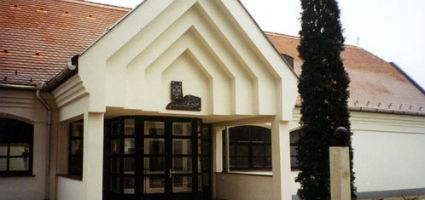2025. July 8. Tuesday
Petőfi House and Memorial Museum - Kiskőrös
 |
Address: 6200, Kiskőrös Petőfi tér 5.
Phone number: (78) 312-566
E-mail: petofimuzeum@koroskabel.hu
Opening hours: Tue-Sun 9-17
|
The most widely known Hungarian poet, Sándor Petőfi was born on 1st January 1823, Kiskőrös. His father was a butcher, and as such they moved all around the county, so the area provides a rich scale of Petőfi relics. The house of the poet's birth was kept in its original state. Moreover, a statue park for translators, which is even unique to Europe, and a literary museum (involving the small galery) were also established there.
The house of Petőfi's birth was built in the 18th century. Its first room keeps the furniture of the family, and its kitchen (characterized by an open chimney) is equipped with utensils of the poet's time. The chamber of the court shows relics and documents of the family's life spent in Kiskőrös.
The ice-pit is still there in the court of the house, and the first public Petőfi statue stands there.
The history of the town and the life work of Petőfi are presented in the new literary museum. We also give an account of how the poet continues to influence Kiskőrös and the world in their way of thinking and every day life.
In the gallery of the museum, there is an exhibition of fine arts representing the life work of Petőfi.
The Slovakian Region House is also a part of the museum. The house represents the life-style and cultural traditions of the Slovakians settled in Kiskőrös at the beginning of the 18th century. In the statue park there stand the statues of 11 foreign poets who had translated the poems of Petőfi into their languages
The house of Petőfi's birth was built in the 18th century. Its first room keeps the furniture of the family, and its kitchen (characterized by an open chimney) is equipped with utensils of the poet's time. The chamber of the court shows relics and documents of the family's life spent in Kiskőrös.
The ice-pit is still there in the court of the house, and the first public Petőfi statue stands there.
The history of the town and the life work of Petőfi are presented in the new literary museum. We also give an account of how the poet continues to influence Kiskőrös and the world in their way of thinking and every day life.
In the gallery of the museum, there is an exhibition of fine arts representing the life work of Petőfi.
The Slovakian Region House is also a part of the museum. The house represents the life-style and cultural traditions of the Slovakians settled in Kiskőrös at the beginning of the 18th century. In the statue park there stand the statues of 11 foreign poets who had translated the poems of Petőfi into their languages
